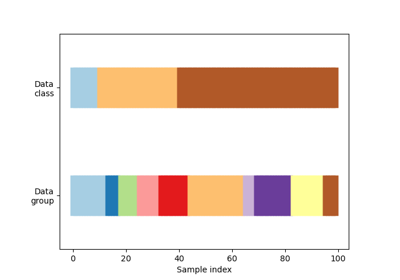sklearn.model_selection.GroupShuffleSplit¶
- class sklearn.model_selection.GroupShuffleSplit(n_splits=5, *, test_size=None, train_size=None, random_state=None)[source]¶
Shuffle-Group(s)-Out cross-validation iterator
Provides randomized train/test indices to split data according to a third-party provided group. This group information can be used to encode arbitrary domain specific stratifications of the samples as integers.
For instance the groups could be the year of collection of the samples and thus allow for cross-validation against time-based splits.
The difference between LeavePGroupsOut and GroupShuffleSplit is that the former generates splits using all subsets of size
punique groups, whereas GroupShuffleSplit generates a user-determined number of random test splits, each with a user-determined fraction of unique groups.For example, a less computationally intensive alternative to
LeavePGroupsOut(p=10)would beGroupShuffleSplit(test_size=10, n_splits=100).Note: The parameters
test_sizeandtrain_sizerefer to groups, and not to samples, as in ShuffleSplit.Read more in the User Guide.
For visualisation of cross-validation behaviour and comparison between common scikit-learn split methods refer to Visualizing cross-validation behavior in scikit-learn
- Parameters:
- n_splitsint, default=5
Number of re-shuffling & splitting iterations.
- test_sizefloat, int, default=0.2
If float, should be between 0.0 and 1.0 and represent the proportion of groups to include in the test split (rounded up). If int, represents the absolute number of test groups. If None, the value is set to the complement of the train size. The default will change in version 0.21. It will remain 0.2 only if
train_sizeis unspecified, otherwise it will complement the specifiedtrain_size.- train_sizefloat or int, default=None
If float, should be between 0.0 and 1.0 and represent the proportion of the groups to include in the train split. If int, represents the absolute number of train groups. If None, the value is automatically set to the complement of the test size.
- random_stateint, RandomState instance or None, default=None
Controls the randomness of the training and testing indices produced. Pass an int for reproducible output across multiple function calls. See Glossary.
See also
ShuffleSplitShuffles samples to create independent test/train sets.
LeavePGroupsOutTrain set leaves out all possible subsets of
pgroups.
Examples
>>> import numpy as np >>> from sklearn.model_selection import GroupShuffleSplit >>> X = np.ones(shape=(8, 2)) >>> y = np.ones(shape=(8, 1)) >>> groups = np.array([1, 1, 2, 2, 2, 3, 3, 3]) >>> print(groups.shape) (8,) >>> gss = GroupShuffleSplit(n_splits=2, train_size=.7, random_state=42) >>> gss.get_n_splits() 2 >>> print(gss) GroupShuffleSplit(n_splits=2, random_state=42, test_size=None, train_size=0.7) >>> for i, (train_index, test_index) in enumerate(gss.split(X, y, groups)): ... print(f"Fold {i}:") ... print(f" Train: index={train_index}, group={groups[train_index]}") ... print(f" Test: index={test_index}, group={groups[test_index]}") Fold 0: Train: index=[2 3 4 5 6 7], group=[2 2 2 3 3 3] Test: index=[0 1], group=[1 1] Fold 1: Train: index=[0 1 5 6 7], group=[1 1 3 3 3] Test: index=[2 3 4], group=[2 2 2]
Methods
Get metadata routing of this object.
get_n_splits([X, y, groups])Returns the number of splitting iterations in the cross-validator
set_split_request(*[, groups])Request metadata passed to the
splitmethod.split(X[, y, groups])Generate indices to split data into training and test set.
- get_metadata_routing()[source]¶
Get metadata routing of this object.
Please check User Guide on how the routing mechanism works.
- Returns:
- routingMetadataRequest
A
MetadataRequestencapsulating routing information.
- get_n_splits(X=None, y=None, groups=None)[source]¶
Returns the number of splitting iterations in the cross-validator
- Parameters:
- Xobject
Always ignored, exists for compatibility.
- yobject
Always ignored, exists for compatibility.
- groupsobject
Always ignored, exists for compatibility.
- Returns:
- n_splitsint
Returns the number of splitting iterations in the cross-validator.
- set_split_request(*, groups: Union[bool, None, str] = '$UNCHANGED$') GroupShuffleSplit[source]¶
Request metadata passed to the
splitmethod.Note that this method is only relevant if
enable_metadata_routing=True(seesklearn.set_config). Please see User Guide on how the routing mechanism works.The options for each parameter are:
True: metadata is requested, and passed tosplitif provided. The request is ignored if metadata is not provided.False: metadata is not requested and the meta-estimator will not pass it tosplit.None: metadata is not requested, and the meta-estimator will raise an error if the user provides it.str: metadata should be passed to the meta-estimator with this given alias instead of the original name.
The default (
sklearn.utils.metadata_routing.UNCHANGED) retains the existing request. This allows you to change the request for some parameters and not others.New in version 1.3.
Note
This method is only relevant if this estimator is used as a sub-estimator of a meta-estimator, e.g. used inside a
Pipeline. Otherwise it has no effect.- Parameters:
- groupsstr, True, False, or None, default=sklearn.utils.metadata_routing.UNCHANGED
Metadata routing for
groupsparameter insplit.
- Returns:
- selfobject
The updated object.
- split(X, y=None, groups=None)[source]¶
Generate indices to split data into training and test set.
- Parameters:
- Xarray-like of shape (n_samples, n_features)
Training data, where
n_samplesis the number of samples andn_featuresis the number of features.- yarray-like of shape (n_samples,), default=None
The target variable for supervised learning problems.
- groupsarray-like of shape (n_samples,)
Group labels for the samples used while splitting the dataset into train/test set.
- Yields:
- trainndarray
The training set indices for that split.
- testndarray
The testing set indices for that split.
Notes
Randomized CV splitters may return different results for each call of split. You can make the results identical by setting
random_stateto an integer.
Examples using sklearn.model_selection.GroupShuffleSplit¶

Visualizing cross-validation behavior in scikit-learn